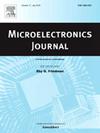Design and analysis of digital-like RF transmitter based on novel harmonic-rejected frequency multiplication architecture
IF 1.9
3区 工程技术
Q3 ENGINEERING, ELECTRICAL & ELECTRONIC
引用次数: 0
Abstract
The increasing use of IoT technology highlights the importance of wireless sensing, where low power consumption and efficient transmission are critical. This paper presents a high-efficiency 400–460 MHz inductorless digital transmitter (TX) tailored for wireless sensing applications. The proposed design incorporates a novel harmonic-rejected frequency multiplication (HRFM) architecture to suppress 3rd- and 5th-order harmonics, ensuring efficient transmission with minimal power consumption. The architecture employs a delay-locked loop (DLL) and a resistance-divider-based edge combiner to both shape the output waveform for harmonic suppression and achieve 9x frequency multiplication. To further optimize DC power consumption, the HRFM generates multipath signals at lower frequencies through the DLL. A feedback-modified, highly matched charge pump (CP) with dynamic current compensation reduces CP charge/discharge current mismatch. Additionally, a dual voltage control approach enhances the operating range of the voltage-controlled delay line (VCDL). Implemented in a 65 nm CMOS process, the transmitter occupies a core area of 0.05 mm2. Simulations show the DLL achieves a spur of approximately 61 dB, while post-layout simulations indicate harmonic distortions greater than −40 dBc for the 3rd-order and −52 dBc for the 5th-order harmonics, all without using inductors. The transmitter delivers −16 dBm output power to a 50 Ω antenna load, with a global DC power consumption of 1.3 mW. Overall, the proposed transmitter demonstrates highly efficient, low-power transmission for wireless sensing applications.
求助全文
约1分钟内获得全文
求助全文
来源期刊

Microelectronics Journal
工程技术-工程:电子与电气
CiteScore
4.00
自引率
27.30%
发文量
222
审稿时长
43 days
期刊介绍:
Published since 1969, the Microelectronics Journal is an international forum for the dissemination of research and applications of microelectronic systems, circuits, and emerging technologies. Papers published in the Microelectronics Journal have undergone peer review to ensure originality, relevance, and timeliness. The journal thus provides a worldwide, regular, and comprehensive update on microelectronic circuits and systems.
The Microelectronics Journal invites papers describing significant research and applications in all of the areas listed below. Comprehensive review/survey papers covering recent developments will also be considered. The Microelectronics Journal covers circuits and systems. This topic includes but is not limited to: Analog, digital, mixed, and RF circuits and related design methodologies; Logic, architectural, and system level synthesis; Testing, design for testability, built-in self-test; Area, power, and thermal analysis and design; Mixed-domain simulation and design; Embedded systems; Non-von Neumann computing and related technologies and circuits; Design and test of high complexity systems integration; SoC, NoC, SIP, and NIP design and test; 3-D integration design and analysis; Emerging device technologies and circuits, such as FinFETs, SETs, spintronics, SFQ, MTJ, etc.
Application aspects such as signal and image processing including circuits for cryptography, sensors, and actuators including sensor networks, reliability and quality issues, and economic models are also welcome.
 求助内容:
求助内容: 应助结果提醒方式:
应助结果提醒方式:


